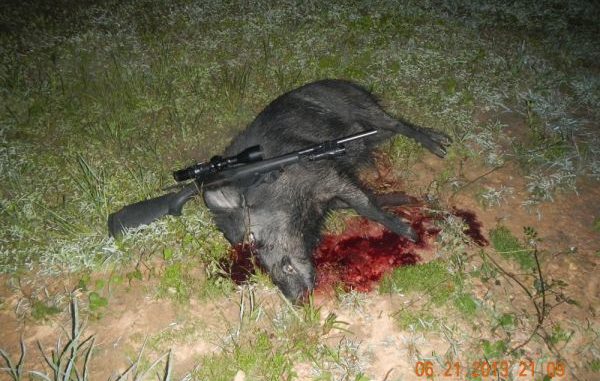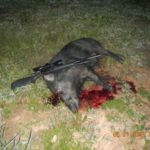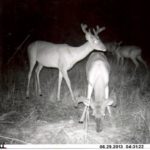
Two hundred pounds of bacon for a buck-fifty; it doesn’t get better than that
Lately, the Moreland clan has been spending a lot of time at the Baton Rouge Orthopedic Clinic; it started with a surgery on my wife’s shoulder for a torn rotator cuff, followed by surgery on our son Ruffin’s leg, followed by an air cast for me to help heal a bad ankle.
On a recent follow-up trip for Ruffin, we were waiting in the examination room, and I picked up a copy of Outdoor Life and began reading an article about a $1 million pig. Ruff told me he had seen that the week before when he and his mother went in prior to his surgery.
Seems like the author and some friends had gone to Texas to shoot pigs out of a helicopter; his buddies had some luck, but he struck out when it was his turn. But he went out at night in the guide’s Land Rover equipped with thermal imaging equipment and other high tech gear, and did kill a hog with a .308 AR.
All total, he figured this hog cost about $1 million dollars with all the equipment these guys use in their hog-control business.
I told Ruffin if we had to spend more than $100 to kill a pig at Camp David, his mom would shut us down.
By the way, on another visit a week later with Ruffin, the technician took the bandage off his wound, looked at it and exclaimed, “This looks good, good, good!”
I figure the sow that I killed and wrote about in the July issue of the Sportsman cost about $1.50 — the price of one .444 cartridge ($35s a box for 20 shells).
I had driven up to Clinton that night following a meeting to do some work the next day, so I am not counting money for gas. When I got to the camp at 10 p.m., I simply slipped out to the big field, spotted the hog and shot it.
So the actual hunt itself was pretty cheap.
Now, I had purchased a couple of bags of ice to keep drinks cold and to cool a hog down in case I had luck, but I do not count these in the cost for the hunt.
Once the meat was in the cooler I did purchase some more ice to keep it nice and cold during the aging process, so I did spend probably $20 dollars on ice.
After killing that hog, I proceeded to get things ready for the next one. I had a five-gallon bucket of corn left over from the 2012 deer season, along with another sack of corn and a sack of rice bran. I set up a bait site on the edge of the field where I had killed the sow, and placed a covert camera on a post to document the visits. I also went ahead and set up two solar lights I had purchased the previous year.
I figure the total cost for all this pre-hunt preparation to be 0, since it was all left over from last year.
Several weeks passed with no activity on the bait other than a deer or two and some crows. Finally, the photos of a nice boar started showing up.
We were up at Clinton on Father’s Day and a check on the bait site showed that the corn was gone, as was most of the rice bran. When the bait is gone and pigs show up and find no bait, it usually takes several days to get them coming again. I put out the last of the corn left over from January and reset the camera.
I went to Clinton on June 21, the weekend of the summer solstice and the time when the moon would be the brightest all year. I stopped at the Co-op store and bought two sacks of corn and two sacks of rice bran. I went to my buddies property and set up a bait site using rice bran and set a camera to record visits.
When I got to Camp David, I found the boar had returned to the bait on the 18th, 19th and 20th, with the first visits starting just prior to 10 p.m. From the photos, it was evident this was an adult boar that probably weighed 200 pounds plus.
There was still some bait at the feeder, so I put in a call to Baton Rouge and advised my wife that I would be home later. I went ahead and put out the other sack of rice bran, and added another sack of corn and made preparations for the evening hunt.
I was in the stand for 9 p.m., and right on schedule at 10 p.m. I could see a black object coming across the field toward the bait site. The hog stopped about 10 yards short, turned around and trotted away, and then stopped and turned back around looking at the feeder.
There was only one solar light working at the bait site, but the moon was so bright I could see the hog quite clearly in my Meoptia scope. I knew from past experience that boars run around the site before finally calming down and coming in to feed, but it was so bright and my crosshairs were clearly visible so I decided to go ahead and take the shot. I rested the rifle on the shooting rail, aimed and fired. I have a light on my rifle but did not turn it on.
It sounded like an explosion when the bullet hit the boar, and I could clearly see the hog on the ground. I climbed down, got the .45 out of the pack and eased over to the animal, and saw that the pistol was not needed. I had hit the boar between the eyes; the bullet had exited through the lower skull and, as the photo shows, there was massive hemorrhaging.
Since the hog did not eat any of the new bait, we can set the cost for this boar at a $1.50, which in my book equates to good, good, good! The boar was 2 to 3 years old, and easily weighed over 200 pounds.
Meanwhile, a week had passed but there was nothing but deer visiting the rice bran at the bait site on the other property: two adult bucks that were probably 4 and 5 years old, a small 3-year-old, a yearling spike and a few does that look like they are ready to birth some fawns.
I was up in Desoto Parish (Area 2) the other day, and saw a doe with a single big fawn that was probably born in May and a doe with twins (probably 1-month-old fawns born in June), so the new fawn crop is starting to show up there in the early rut area. Right now, with those two sightings, fawn recruitment is 1.5 fawns per adult doe, not too bad. From a deer management standpoint, things are good, good, good.
I also noticed that there appeared to be a nice crop of sawtooth oak acorns again this year, and there were numerous clusters of pears on the pear trees. The cowpeas and joint vetch at Camp David are being browsed by the deer and the clover and chickory strips are still as green as they were in the spring. Sunflowers are beginning to bloom, and the sorghum heads are developing. From a habitat standpoint things, are really good, good, good. In fact, the nutrition available to deer this year is the best in years.
While cameras were set to record hogs and deer, they have also photographed turkeys, with several photos of hens with poults. Yes, indeed: It is still good, good, good!
Oh wait: I forgot that, before shooting this boar I had taken the time to purchase my 2013 Senior Hunting and Fishing License. So we have to add $5 to the hunt cost of the boar, which brings the total to $6.50.
While our low-budget hog operation lacks the technology of the one in Texas, the results are the same: bacon, bacon, bacon!




